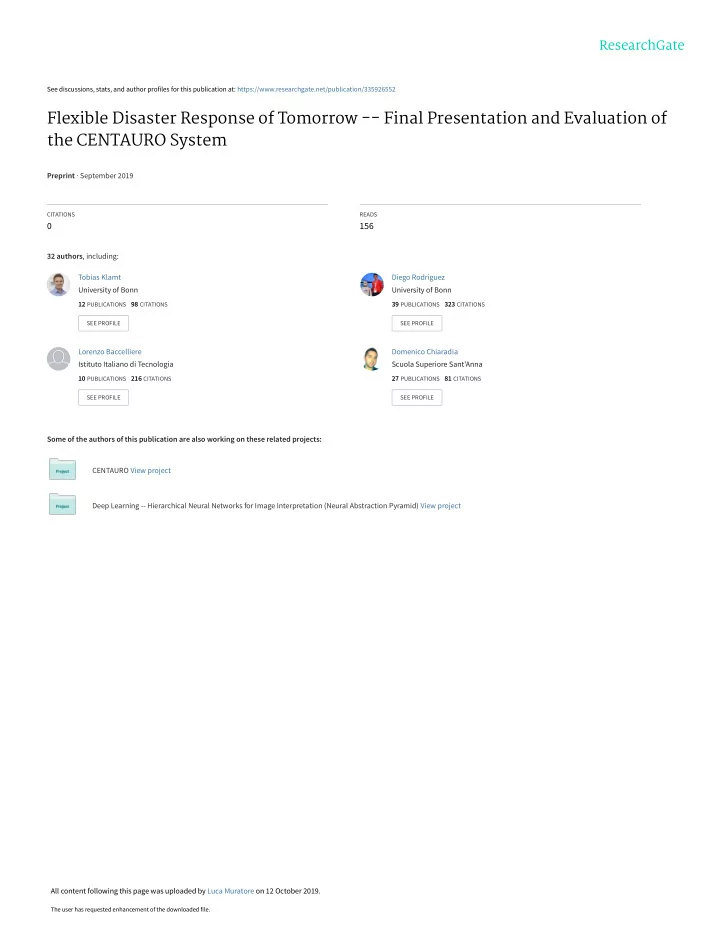

See discussions, stats, and author profiles for this publication at: https://www.researchgate.net/publication/335926552 Flexible Disaster Response of Tomorrow -- Final Presentation and Evaluation of the CENTAURO System Preprint · September 2019 CITATIONS READS 0 156 32 authors , including: Tobias Klamt Diego Rodriguez University of Bonn University of Bonn 12 PUBLICATIONS 98 CITATIONS 39 PUBLICATIONS 323 CITATIONS SEE PROFILE SEE PROFILE Lorenzo Baccelliere Domenico Chiaradia Istituto Italiano di Tecnologia Scuola Superiore Sant'Anna 10 PUBLICATIONS 216 CITATIONS 27 PUBLICATIONS 81 CITATIONS SEE PROFILE SEE PROFILE Some of the authors of this publication are also working on these related projects: CENTAURO View project Deep Learning -- Hierarchical Neural Networks for Image Interpretation (Neural Abstraction Pyramid) View project All content following this page was uploaded by Luca Muratore on 12 October 2019. The user has requested enhancement of the downloaded file.
Accepted for IEEE Robotics and Automation Magazine (RAM), to appear December 2019. Flexible Disaster Response of Tomorrow Final Presentation and Evaluation of the CENTAURO System Tobias Klamt 1 , Diego Rodriguez 1 , Lorenzo Baccelliere 2 , Xi Chen 3 , Domenico Chiaradia 4 , Torben Cichon 5 , Massimiliano Gabardi 4 , Paolo Guria 2 , Karl Holmquist 6 , Malgorzata Kamedula 2 , Hakan Karaoguz 3 , Navvab Kashiri 2 , Arturo Laurenzi 2 , Christian Lenz 1 , Daniele Leonardis 4 , Enrico Mingo Hoffman 2 , Luca Muratore 2,9 , Dmytro Pavlichenko 1 , Francesco Porcini 4 , Zeyu Ren 2 , Fabian Schilling 7 , Max Schwarz 1 , Massimiliano Solazzi 4 , Michael Felsberg 6 , Antonio Frisoli 4 , Michael Gustmann 8 , Patric Jensfelt 3 , Klas Nordberg 6 , J¨ urgen Roßmann 5 , Uwe S¨ uss 8 , Nikos G. Tsagarakis 2 , and Sven Behnke 1 arXiv:1909.08812v1 [cs.RO] 19 Sep 2019 1 Autonomous Intelligent Systems, University of Bonn, Germany 2 Humanoids and Human-Centred Mechatronics, Istituto Italiano di Tecnologia, Genoa, Italy 3 Department of Robotics, Perception and Learning, KTH Royal Institute of Technology, Stockholm, Sweden 4 PERCRO Laboratory, TeCIP Institute, Sant’Anna School of Advanced Studies, Pisa, Italy 5 Institute for Man-Machine Interaction, RWTH Aachen University, Germany 6 Computer Vision Laboratory, Link¨ oping University, Sweden 7 Laboratory of Intelligent Systems, Swiss Federal Institute of Technology (EPFL), Lausanne, Switzerland 8 Kerntechnische Hilfsdienst GmbH, Karlsruhe, Germany 9 School of Electrical and Electronic Engineering, The University of Manchester, United Kingdom Mobile manipulation robots have high potential to sup- disaster illustrated the gap between robot capabilities and port rescue forces in disaster-response missions. Despite real-world requirements. In such scenarios, a combination of the difficulties imposed by real-world scenarios, robots are locomotion and manipulation skills is required. Locomotion promising to perform mission tasks from a safe distance. In tasks include, e.g., energy-efficient traversal of longer dis- the CENTAURO project, we developed a disaster-response tances to approach the disaster site, navigation in man-made system which consists of the highly flexible Centauro robot environments such as corridors, doors, ramps, and staircases, and suitable control interfaces including an immersive tele- as well as overcoming cluttered obstacles or gaps which are presence suit and support-operator controls on different lev- caused by the disaster. Examples for manipulation tasks are els of autonomy. the moving of heavy obstacles to clear paths, interactions in In this article, we give an overview of the final made-for-human environments such as (dis)connecting plugs CENTAURO system. In particular, we explain several high- or passing locked doors, as well as using made-for-human level design decisions and how those were derived from electrical tools such as power drills. Further challenges requirements and extensive experience of Kerntechnische include: necessary energy resources have to be on board, Hilfsdienst GmbH, Karlsruhe, Germany (KHG) 1 . We focus direct visual contact between an operator and the robot is not on components which were recently integrated and report available, and maintenance during a mission is not possible— about a systematic evaluation which demonstrated system putting the focus on system robustness. capabilities and revealed valuable insights. In recent years, continuous developments in actuation, sensing, computational hardware, and batteries enabled the I. D ISASTER R ESPONSE NEEDS F LEXIBLE R OBOTS AND development of robotic platforms which provide essential I NTUITIVE T ELEOPERATION features like flexibility, precision, strength, robustness, en- Natural and man-made disaster response have increasingly ergy efficiency, and compactness such that robots can be attracted attention in the last decade because of their large deployed in environments designed for humans. In the 2015 potential impact. One example is the Fukushima disaster in DARPA Robotics Challenge, teams were required to solve March 2011 in which a Tsunami hit the Japanese coast— a set of mostly known locomotion and manipulation tasks including the Fukushima Daiichi nuclear power plant— and demonstrated the state-of-the-art for applied mobile resulting in a nuclear disaster. There, rescue workers faced manipulation robots. Successful robot entries include DRC- considerable risks to their health [1]. HUBO, Momaro, CHIMP, and RoboSimian [2–5]. More Although mobile manipulation robots have much potential recent mobile manipulation robots are, e.g., RoboMantis [6] to replace humans in such cases, the Fukushima nuclear and Spot [7] which possess flexible kinematic capabilities but no methods to control these platforms have been presented. The humanoid Toyota T-HR3 [8] and the WALK-MAN Author contact: Tobias Klamt <klamt@ais.uni-bonn.de> . This work was supported by the European Union’s Horizon 2020 Pro- robot attached to a wheeled base [9] have been controlled gramme under Grant Agreement 644839 (CENTAURO). through a head-mounted display (HMD) and by mirroring 1 KHG is part of the German nuclear disaster-response organization and user movements to the robot. In the case of T-HR3, additional a potential end-user of the system
Recommend
More recommend